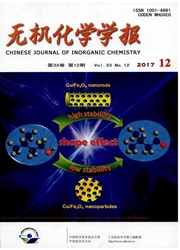

 中文摘要:
中文摘要:
采用微乳液法制备NaLu(WO4)2-x(MoO4)x∶8%Eu^3+(x=0,0.5,1.0,1.5,2.0)/y%Eu^3+,5%Tb^3+(y=1,3,5,7,9)系列荧光粉.通过X射线衍射(XRD)表征,所制样品的X射线衍射峰与标准卡片PDF#27-0729基本吻合,表明所制的样品为白钨矿结构,属于四方晶系.扫描电镜(SEM)显示制备的纳米粒子是梭子状的,粒径大约是110 nm.激发发射光谱显示,在Eu^3+离子掺杂物质的量分数为8%时,NaLu(WO4)(MoO4)∶Eu^3+发光强度最大.NaLu(WO4)2-x(MoO4)x∶8%Eu^3+(x=0,0.5,1.0,1.5,2.0)荧光粉在nMo/n比达到1∶1(x=1)时发光强度最大,强烈的红光发射表明该材料可用于白光LED材料.该荧光粉在268、394和466 nm波长光激发下分别发出橙红色、黄色和淡黄色光,可以满足不同光色需要.NaLu(WO4)(MoO4):y%Eu^3+,5%Tb^3+(y=1,3,5,7,9)荧光粉,随着y值增大,从绿光区(x=0.278,y=0.514)进入白光区(x=0.356,y=0.373),(x=0.278,y=0.313),同时观察到Tb3+到Eu3+有效能量传递.
 英文摘要:
英文摘要:
8%Eu^3+/y%Eu^3+,5%Tb^3+(y=1, 3, 5, 7, 9)codoped NaLu(WO4)2-x(MoOa)x (x=0, 0.5, 1.0, 1.5, 2.0) phosphor were prepared via microemulsion method at room temperature. X-ray diffraction (XRD), scanning electron microscopy (SEM) and fluorescence spectroscopy were used to characterize the samples. The XRD of as-prepared samples were in agreement with the PDF#27-0729, showing that sample was the scheelite structure, belongs to the tetragonal crystal system. SEM images showed that the as-prepared particles were shuttle. Particle size was about 110 nm. The critical activator molar concentration (Eu^3+) in NaLu(WO4)(MoO4):Eu^3+ was 8%. As the Mo content increased, the intensity of emission of Eu^3+ activated at wavelength of 394 nm and 466 nm increased and reached a maximum when the relative ratio of nMo/nw was 1:1. The intense red-emission of the tungstomolybdate phosphors at near-UV and blue excitation suggested that the material was a potential candidate for white light emitting diode (WLEDs). This phosphor excited by 268, 394 and 466 nm, exhibited orange-red, yellow and pale yellow respectively, meeting the needs of the different light color. In the systems of NaLu(WO4)(MoO4):y%Eu^3+,5%Tb3+(y=1, 3, 5, 7, 9) phosphors, with the increase of the doped concentration of Eu^3+(y), the emission color of the co-doped NaLu(WO4)(MoO4) phosphors can be tuned precisely from green (x=0.278, y=0.514)to white (x=0.356, y=0.373), (x=0.385, y=0.313). At the same time, a very efficient energy-transfer from Tb^3+ to Eu^3+can be observed.
 同期刊论文项目
同期刊论文项目
 同项目期刊论文
同项目期刊论文
 期刊信息
期刊信息
